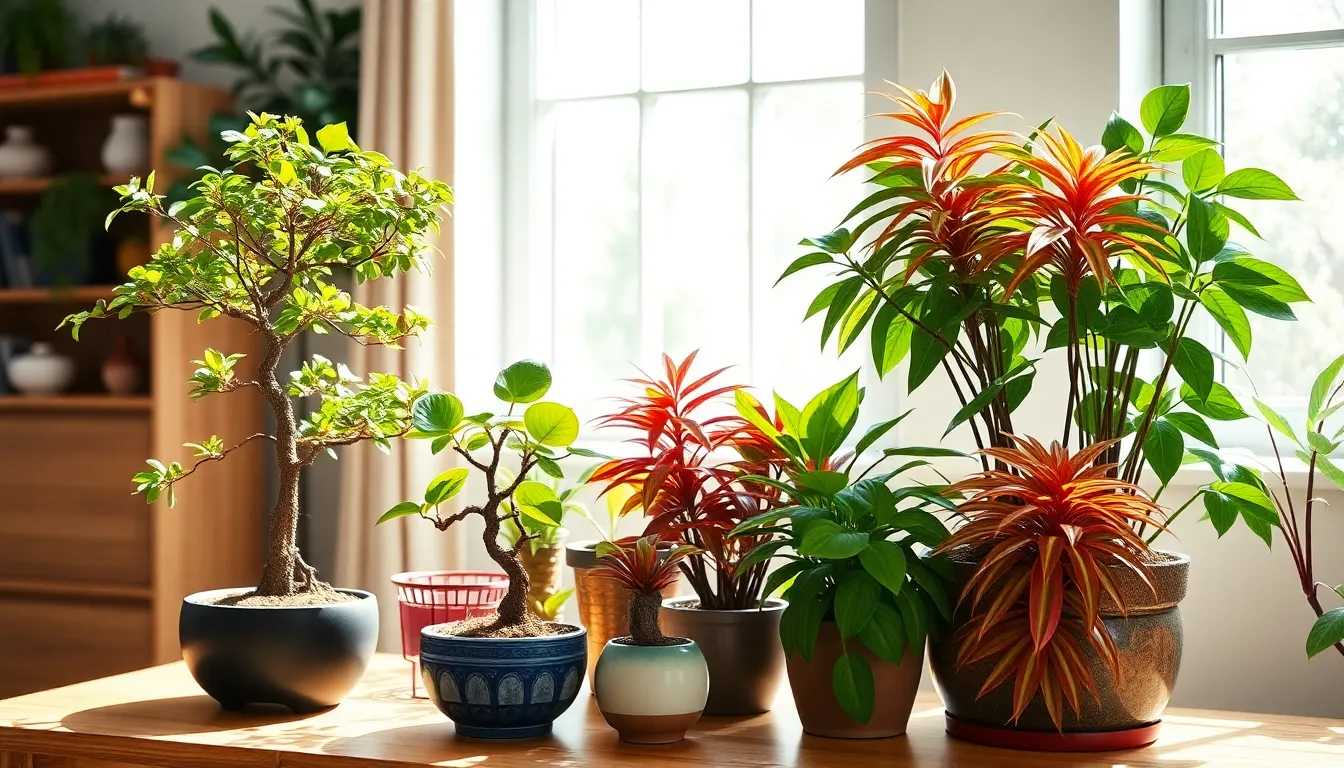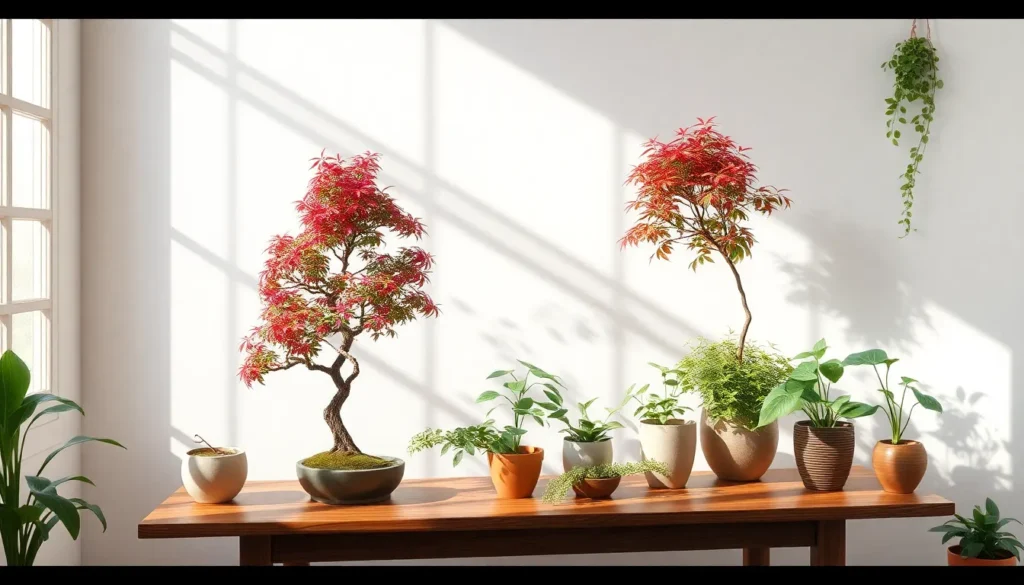Table of Contents
ToggleJapanese house plants are more than just greenery; they’re a lifestyle choice that brings serenity and beauty into any space. Imagine walking into your home and being greeted by the soothing presence of a lush bonsai or a vibrant peace lily. These plants don’t just sit around looking pretty; they purify the air and elevate your mood.
But let’s be honest—keeping plants alive can feel like a high-stakes game of survival. Fear not! With the right tips and tricks, even the most plant-challenged individuals can cultivate a thriving indoor jungle. From the resilient snake plant to the elegant orchid, Japanese house plants offer a delightful blend of aesthetics and low maintenance. So, grab your watering can and get ready to transform your home into a tranquil oasis that even your cat will appreciate.
Overview Of Japanese House Plants
Japanese house plants play a vital role in creating an inviting atmosphere within homes. These plants not only enhance interior aesthetics but also promote tranquility and well-being. Varieties like the snake plant and pothos require minimal care and fit well into busy lifestyles. Those seeking more delicate options can choose from flowering plants such as orchids or the iconic bonsai, which require more attention but reward with beauty.
The practice of incorporating plants into living spaces has deep roots in Japanese culture, symbolizing a connection to nature. Many households embrace this philosophy, using plants to foster a calming and peaceful ambiance. Air purification remains a significant benefit, with various species effectively removing toxins and improving indoor air quality.
Japanese house plants also hold cultural significance. For instance, bamboo reflects resilience and flexibility, while chrysanthemums symbolize longevity and rejuvenation. These meanings deepen the appreciation of plants within a home.
Specific care requirements must be met for successful plant maintenance. Proper light exposure and humidity levels remain crucial for success. Research indicates that many Japanese house plants thrive in indirect light, making them suitable for various rooms.
Engaging in indoor gardening has become a popular pursuit. This hobby provides a sense of accomplishment while beautifying living spaces. As individuals connect with nature through cultivation, they also contribute to their overall happiness and mental health.
Ultimately, the integration of Japanese house plants offers a unique way to enhance home environments, creating havens of peace and beauty.
Popular Types Of Japanese House Plants

Japanese house plants offer diverse options that enhance indoor spaces. Some of the most popular types include bonsai trees, Ficus varieties, and Japanese maple.
Bonsai Trees
Bonsai trees represent the art of miniature gardening. These small, sculpted trees symbolize patience and dedication in cultivation. Various species, such as Juniper, Maple, and Pine, thrive as bonsai. Acquiring the right tools for pruning and wiring ensures healthy growth. Ensuring proper watering and sunlight promotes vitality in bonsai trees. Maintaining these plants requires attention, making them satisfying projects for gardeners.
Ficus
Ficus plants boast several species well-suited for indoor environments. Ficus lyrata, commonly known as fiddle leaf fig, features large, glossy leaves that create a stunning focal point. Another popular option is the Ficus elastica, or rubber plant, which provides glossy leaves and adaptability in various lighting conditions. Appropriate watering and humidity levels are critical for these plants to flourish. They also effectively purify the air, contributing to a healthier home atmosphere.
Japanese Maple
Japanese maple trees, known for their vibrant foliage, enhance any indoor setting. Varieties such as Acer palmatum offer stunning leaves that change colors with seasons. These trees require well-draining soil and adequate sunlight for optimal growth. Cultivating a Japanese maple involves regular maintenance to preserve its shape and health. Adding these trees to indoor spaces creates a serene ambiance and a connection to nature.
Care Tips For Japanese House Plants
Caring for Japanese house plants involves understanding their specific needs. Successful maintenance hinges on tailored approaches for watering, light, and soil.
Watering Requirements
Watering frequency depends on plant type and environmental conditions. Ficus plants prefer slightly moist soil, while bonsai trees require more precise moisture levels. Overwatering can lead to root rot, so it’s crucial to check soil dryness. A simple method involves sticking a finger into the soil about an inch deep; if it feels dry, it’s time to water. For optimal health, use distilled or rainwater, as tap water can contain chemicals that may harm the plants.
Light Conditions
Light exposure greatly influences growth. Most Japanese house plants thrive in bright, indirect sunlight. Bonsai trees flourish under filtered light, while Ficus varieties tolerate lower light levels but prefer brighter spots. When placing plants, consider rotating them every few weeks to promote balanced growth on all sides. Additionally, sudden shifts in light conditions can stress the plants, so adjustments should be gradual.
Soil Preferences
Soil type plays a significant role in plant health. A well-draining potting mix works best for most Japanese house plants, particularly those like bonsai. Ideal mixtures often include components like peat, perlite, and akadama, which encourage proper drainage and aeration. For Ficus varieties, a standard indoor potting soil suffices, but ensuring sufficient drainage is vital. Regular repotting every couple of years helps refresh soil nutrients and prevent compaction.
Cultural Significance Of Japanese House Plants
Japanese house plants hold profound cultural significance, representing the deep-rooted connection between nature and daily life. The appreciation for these plants reflects Japan’s historical reverence for nature, especially in traditional practices like bonsai, which embodies harmony and balance. In Japanese culture, these plants symbolize patience, dedication, and the beauty of imperfection.
Indoor gardening offers a way to cultivate tranquility within the home. Fostering a serene environment, plants contribute to mental well-being, promoting relaxation and reducing stress. Furthermore, house plants often serve as a reminder of the changing seasons, showcasing vibrant foliage and blooms that change throughout the year.
Specific plants carry unique meanings. For instance, the bonsai tree signifies not only aesthetic beauty but also the commitment involved in its care. Similarly, the Ficus species are not only versatile but also known for their air-purifying qualities, reinforcing the belief in nurturing a healthy living space. Japanese maple trees add elegance with their stunning colors, representing seasonal change and renewal.
Emphasizing care rituals plays a crucial role in maintaining these plants’ cultural relevance. Proper care reflects respect for nature and aligns with the Japanese philosophy of mindfulness. Regular watering and attention to light conditions demonstrate a commitment to nurturing life, enhancing both the indoor environment and personal well-being.
Integrating these plants into home decor resonates within Japanese aesthetics, where simplicity and natural beauty reign. The presence of greenery transforms spaces, fostering a sense of peace and enhancing overall quality of life. Cultivating Japanese house plants enriches personal spaces while deepening the connection to cultural heritage.
Japanese house plants offer more than just aesthetic appeal; they embody a deep cultural connection to nature and tranquility. By integrating these plants into home environments, individuals can cultivate serenity and enhance their overall well-being. The commitment to plant care reflects a philosophy of mindfulness that resonates with the beauty of imperfection and the changing seasons.
With a variety of options available from low-maintenance snake plants to the intricate bonsai, anyone can find the right fit for their lifestyle. Embracing indoor gardening not only beautifies living spaces but also fosters a sense of peace and connection to cultural heritage. This journey into the world of Japanese house plants invites everyone to create their own peaceful haven.







